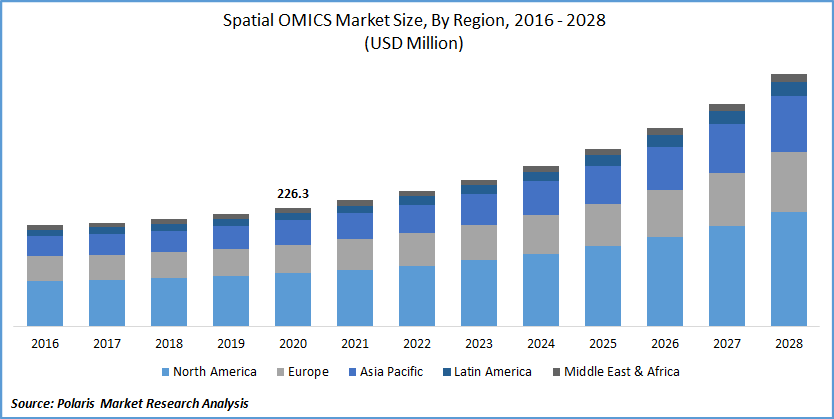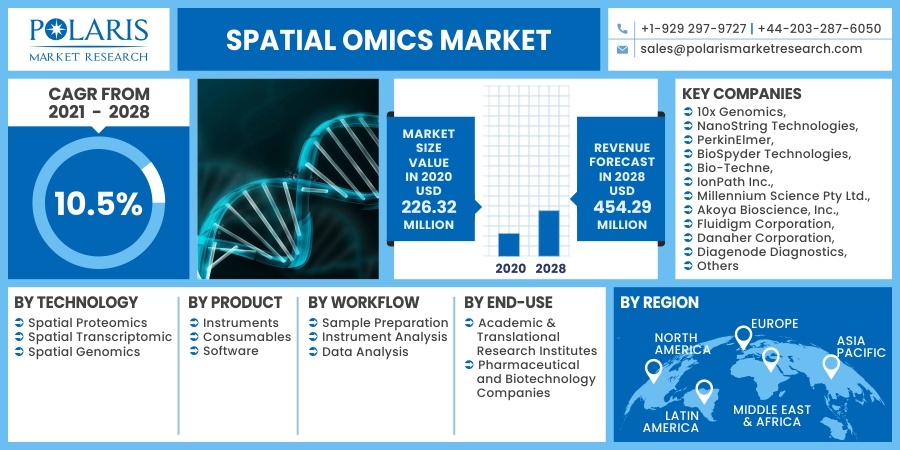
Spatial OMICS Market Share, Size, Trends, Industry Analysis Report
By Technology (Spatial Proteomics, Spatial Transcriptomics, Spatial Genomics); By Product (Instruments, Consumables, Software); By Workflow (Sample Preparation, Instrument Analysis, Data Analysis), By End-use, By Region; Segment Forecast, 2021 - 2028
- Published Date:Oct-2021
- Pages: 111
- Format: PDF
- Report ID: PM2101
- Base Year: 2020
- Historical Data: 2016 - 2019
Report Outlook
The global spatial OMICS market was valued at USD 226.32 million in 2020 and is expected to grow at a CAGR of 10.5% during forecast period. The acceleration in the market is mainly observed by the technological advancements in the spatial OMICS, coupled with the vigorous growth in penetration of the spatial analyzes as it provides better molecular studies with the help of spatial information. Furthermore, the emerging and existing companies in the market are leading the significant introduction of innovative ideas, which, in turn, are expanding the acceptance of spatial OMICS globally. For example, GeoMX DSP (Digital Spatial Profiler) is produced by the NanoString that assists the quantification of approximately 1,800 RNA targets which also comprises COVID 19 receptors and proteases. Hence, this positively influences the development of the market.
 Know more about this report: request for sample pages
Know more about this report: request for sample pages
It is a term used to summarize numerous distinct analyses, such as metabolomics, transcriptomics, lipidomics, proteomics, and genomics. It provides the contact of technology for spatially determined RNA, small molecule, and protein analyses of histological tissue sections. It is promising to perform detailed biomolecular-performing while conserving the inborn morphology of the cell for the examination of the cell-ECM and cell-cell exchanges, which eventually paving the way for the growth of the global market over the foreseen period.

Know more about this report: request for sample pages
Industry Dynamics
Growth Drivers
The global surge in prevalence of cancer in developed and developing economies, coupled with the robust growth of the geriatric population with a chronic disease like cancer, extensively requires targeted studies and analyses of the intricate tumor micro-environment to comprehend tumor immunogenicity. This elaborates the well-defined molecular profiles that are linked with immune cell exhaustion along with activation.
For instance, it was projected in 2018 that around 9.5 million cancer deaths and about 17.0 million new cases of cancer were registered all over the world. And as per the International Agency for Research on Cancer (IARC), it is anticipated that there will be about 16.3 million deaths and nearly 27.5 new million cases of cancer by 2040. These are the key forces that stimulate the demand for the global market.
As cancer incidence rates have progressively increased over the past two decades, while mortality rates have exhibited a significant decline. While at the same time, the significant variation in survival rates is still witnessed across cancer types (such as there are over 200 distinct diseases recognized), for most classes, survival is improving due to earlier diagnosis and enhanced treatments. Following this, this technology has emerged as a new and integral approach as a cancer diagnostic tool. Thus, these novel diagnostics tools options are expected to amplify the demand for the global spatial OMICS market.
Additionally, the emergence of various companies in the market aiming to invest in the significant progress for spatial OMICS studies in the wide range of solutions, which may endorse the market demand for this industry around the globe. Furthermore, key players of the market emphasize intensifying their genomic footprints and spatial transcriptomics by implementing growth strategies for escalating their existence in the market. Moreover, such companies are captivating strategies by formulating deliberate collaborations or partnerships with the other prominent market players.
Report Segmentation
The market is primarily segmented on the basis of technologies, product, workflow, end-use, region.
|
By Technology |
By Product |
By Workflow |
By End-Use |
By Region |
|
|
|
|
|
Know more about this report: request for sample pages
Insight by Technology
Among the technology segment, the segment of spatial transcriptomics held the largest pole in the global market in 2020. Frequent innovations in sequencing technologies may augment the transcriptomic study of single cells. In addition, using this method to determine the subcellular localization of mRNA molecules is further possible by the technology. On the other hand, the technology makes the easy study of the genomic analysis possible to fulfill the requirements of the biological specimens of the nucleic acid or single cells. These factors may positively influence the rise of the global market.
These technical methods often led to the significant conjunction of the function-oriented area of molecular genetics and biochemistry with structure-focused areas, including embryology and histology, thereby allowing spatially determined molecular analysis of biological procedures. This makes the genomics segment expand at the fastest CAGR during the forecast period.
Insight by Product
The consumable segment is anticipated to grasp the large revenue in the global market because of the introduction of the innovative products in the market coupled with the growing utilization rate of the segment. For instance, in December 2020, NanoString declared the changes and advancements in its spatial molecular imager (SMI). For the studies of the FFPE tissue samples in the RNA and multiplexed protein analyses, this next-generation platform is proposed for the analyses of the single cells. The introduction of the new instruments is straightly linked with the market growth of the consumables.
On the other side, the software segment is expected to show a growing market share by 2028. Increasing utilization of the various tools for the analyses of the single-cell spatial OMICS data, consolidative analyses, visualization of spatial expression data, and statistical studies of the spatial pattern are the various factors that lead the market growth of the segment in the foreseen period.
Geographic Overview
Geographically, North America conquered the global spatial OMICS market and accounted for the largest share in terms of income owing to the rising incidences of cancer, increasing healthcare investments along with sophisticated facilities in the hospitals, and the accessibility of the diagnostic techniques. Moreover, the strategic investments in the research and development of disease pathology and the growing focus on transcriptomics in an end-use application are further strengthening the region’s growth.
In the Asia Pacific region, the global market elaborates the highest CAGR in the upcoming years. For intensifying the biological research and development activities, large numbers of companies are coming into an agreement that may fuel the region’s growth. For example, the availability of the CRISPR/Cas9 patent portfolio was approved by the ERS Genomics Limited to the G+FLAS Life Sciences, Inc. is a biotechnology start-up from South Korea, in February 2021. This promised contract assisted the firm in evolving genome editing applications with CRISPR/Cas9.
Competitive Insight
Some of the major players operating the global spatial OMICS market include 10x Genomics, Akoya Bioscience, Inc., Biognosys AG, BioSpyder Technologies, Bio-Techne, Bruker, and Brooks Automation, Inc., Danaher Corporation, Diagenode Diagnostics, Fluidigm Corporation, IonPath Inc., Millennium Science Pty Ltd., NanoString Technologies, PerkinElmer, Rebus Biosystems, Ultivue, Inc., Vizgen Corp.
Spatial OMICS Market Industry Developments
- December 2023: PerkinElmer completed the acquisition of Covaris, a well-known provider of solutions pushing progress in the life sciences. Through this acquisition, PerkinElmer's life sciences portfolio extends into the quickly growing diagnostics market.
- November 2023: 10x Genomics and OWKIN announced a collaboration to add 10x’s spatial OMICS and single-cell technologies to the MOSAIC project.
Spatial OMICS Market Report Scope
|
Report Attributes |
Details |
|
Market size value in 2020 |
USD 226.32 million |
|
Revenue forecast in 2028 |
USD 454.29 million |
|
CAGR |
10.5% from 2021 - 2028 |
|
Base year |
2020 |
|
Historical data |
2016 - 2019 |
|
Forecast period |
2021 - 2028 |
|
Quantitative units |
Revenue in USD million and CAGR from 2021 to 2028 |
|
Segments covered |
By Technologies, By Product, By Workflow, By End-Use, By Region |
|
Regional scope |
North America, Europe, Asia Pacific, Latin America, Middle East & Africa |
|
Key Companies |
10x Genomics, NanoString Technologies, PerkinElmer, BioSpyder Technologies, Bio-Techne, IonPath Inc., Millennium Science Pty Ltd., Akoya Bioscience, Inc., Fluidigm Corporation, Danaher Corporation, Diagenode Diagnostics, Rebus Biosystems, Ultivue, Inc., Biognosys AG, Vizgen Corp., Bruker, and Brooks Automation, Inc. |
